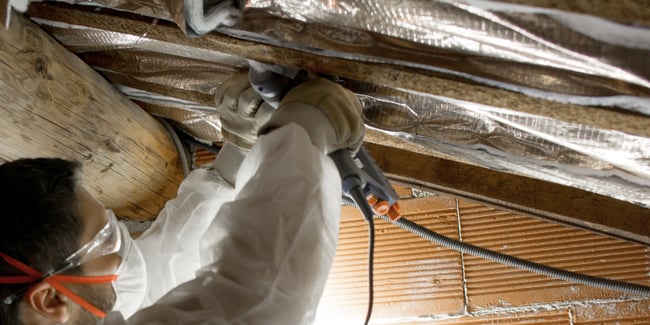With the season rapidly approaching, Washington State homeowners have the important task of preparing their homes for the harsh conditions of winter weather. Taking action now to prepare your home for winter can save you a lot of trouble when freezing temperatures and powerful storms head your way.
Prepare Your Home for Winter: Checklist
The changing seasons mean changing your care routine for your home. While winter brings the holiday season and lots of good cheer, homeowners in Washington can expect a great deal of rain, and falling leaves and pine needles that can wreak havoc on their homes — if they aren’t prepared.
With so much to do before the start of the season, we’ve put together a basic checklist to help you prepare your home for fall and winter.
Exterior Home Preparations
With inclement weather on the horizon this season for the Puget Sound region, the first and most important task to tackle is protecting the exterior of your home.
Before winter begins and throughout the season, check the outside finishes on your home to save yourself any trouble once winter weather comes along. Check out these tips on preparing the exterior of your home for the winter.

Roofs/Gutters
The exterior of your house will take the brunt of the winter weather, especially when it rains and snows. Before the Pacific Northwest chill rolls through in your area, inspect and clean your gutters and downspouts. Be sure the area where your downspout connects to the drain is clear of yard debri. Check your roof and vents for any broken or missing shingles. It’s better to find any issues that may cause leaks later in the season and fix them now.
Windows and Doors
Another vital component to prepare your home for winter weather is checking doors and windows to make sure they are secure and weather-resistant.
A major key to winter preparation is to prevent catastrophic leaks. Clean the tracks of windows and sliding glass doors before applying silicone lubricant to ensure maximum seal. Make sure they are free of any debris and that weep holes (passages for water to drain and ventilate) are open to ensure minimal leakage.
 If you see any wear and tear on your windows and doors as you are preparing your home for winter, apply caulking as needed to prevent future issues.
If you see any wear and tear on your windows and doors as you are preparing your home for winter, apply caulking as needed to prevent future issues.
Siding and Insulation
Having proper insulation can be vital to making sure your home is cozy and warm enough for the dropping temperatures ahead. Make sure you have quality insulation in the home to keep down heating costs and, most importantly, keep heat inside the house where it belongs.
Heavy winds, low temperatures, and precipitation can destroy any damaged siding on your home. Repairing or replacing siding that needs some help can prevent extreme damage to the exterior of your home before winter comes.
Make sure you give your attic and crawl spaces some love too. Periodically check these spaces for any moisture intrusion to save yourself from the risk of leaks, mold, and more.
Heating System Maintenance
Most homeowners forget about heating system maintenance in the summertime while they are using their air conditioning. With an average low temperature of 39 degrees in the Seattle area during the winter, it’s important to keep your home warm and prevent any issues with your heating system while you can.
Schedule professional maintenance for your furnace or heating system before the start of winter to ensure it is working properly. Make sure you ask a licensed HVAC contractor to change old filters and remove any debris on or around the exterior compressor.
One of the most charming parts of winter is a relaxing fire in the fireplace. However, after months of no use, it’s important for homeowners to get their chimneys inspected and cleaned to prevent any fires
If you use your fireplace, don’t forget to stock up on firewood in advance in case you lose power and need to stay warm.
Plumbing and Pipes
As you create a checklist for preparing your home for winter, add plumbing and pipe maintenance. Frozen pipes are bad news for homeowners and can cause a lot of serious issues.
Before the start of winter, insulate exposed pipes to prevent the risk of leakage. Turn off water to outside faucets, disconnect garden hoses that may prevent faucets from properly draining, and use faucet covers to reduce the risk of frozen pipes.
Taking these steps when preparing your home for fall and winter can save you a whole lot of trouble down the line and prevent disastrous leaks.
Landscape and Yard
As winter comes, it’s time to say goodbye to the beautiful greenery in our yards and say hello to crispy leaves.

 To prepare for the transition, trim and prune your trees and shrubs and rake any leaves or debris before it starts to snow. Turn off and winterize any exterior irrigation systems and keep drainage paths or grates clean of debris to prevent water buildup.
To prepare for the transition, trim and prune your trees and shrubs and rake any leaves or debris before it starts to snow. Turn off and winterize any exterior irrigation systems and keep drainage paths or grates clean of debris to prevent water buildup.
This can not only save your yard from damage but can prevent damage to the neighborhood as well.
Energy Efficiency Tips
Since we use so much heat in the winter, conserving energy during the winter months is essential — especially when a big winter storm is headed your way.
Making sure your home keeps in heat is easy if you take the proper steps. Install a programmable thermostat to easily conserve heat and energy at the click of a button. Use weatherstripping tape and draft stoppers for your doors to prevent air leaks and preserve heat.
 Looking for more tips to conserve energy and keep costs down throughout the winter? Here are some other things you can do:
Looking for more tips to conserve energy and keep costs down throughout the winter? Here are some other things you can do:
- Conserve electricity by turning off lights when not in use
- Keep your thermostat at a lower temperature during the day
How to Prepare Your Home for a Winter Storm
One of the most important parts of prepping for the new season is making sure your home is ready for a winter storm. Some heavy rain, wind and snowstorms can leave you without power or the ability to leave your home. It’s important as a homeowner to ensure you are ready for the worst-case scenario.
Make sure your home has storm windows and doors that resist strong winds and heavy snow. Familiarize yourself with any shutoff valves or switches so you know where to go and what to do in an emergency.
 Stock your home with an emergency kit with essentials like non-perishable canned goods, water bottles, first aid supplies, candles, and more. Throw in a list of emergency contacts in case you are unable to access your cellphone in an emergency.
Stock your home with an emergency kit with essentials like non-perishable canned goods, water bottles, first aid supplies, candles, and more. Throw in a list of emergency contacts in case you are unable to access your cellphone in an emergency.
Taking the time to prepare your home before the start of the season can save you a lot of hassle and prevent a possible life-threatening situation in the event of a dangerous winter storm.
Wrapping Up Winter Preparations for Your Home
We hope you take these tips to prepare your home for the winter and start your efforts early before the start of the season.
Making sure you protect your home’s exterior, heating system, pipes, landscaping, and more against extreme winter weather can help prevent any potentially dangerous or costly issues and — most importantly — protect you and your family.
If you need more information on winterizing your home with professional assistance, read our full maintenance manual today.


